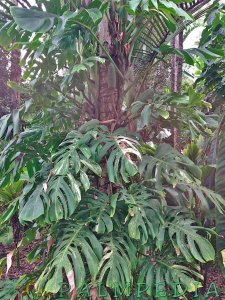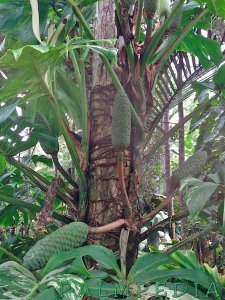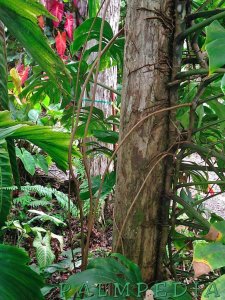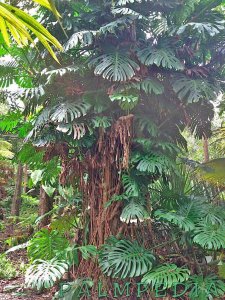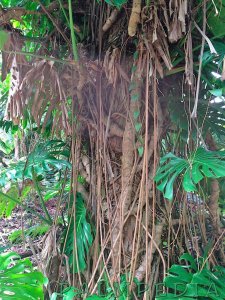You are using an out of date browser. It may not display this or other websites correctly.
You should upgrade or use an alternative browser.
You should upgrade or use an alternative browser.
Variegated Monstera deliciosa/
- Thread starter Stan
- Start date
- 9,565
- 28/09/07
- 121
- 223
Good find Stan - Here's a small grouping of mine. A good grower when given something to climb on and get its roots into. There is one with yellow variegation that I have only seen a few times, and offered for a pretty penny. I have not ever seen that one over here, only in SoCal many years ago.
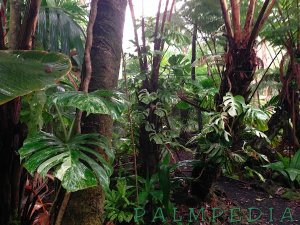
But here's another variegated Philo that I got yesterday. It's a real beauty, and going to be a big boy. The "trunk" is already about 3 inches in diameter, with large leaves.
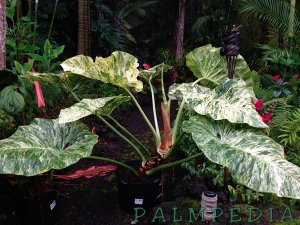
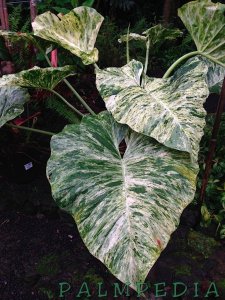

But here's another variegated Philo that I got yesterday. It's a real beauty, and going to be a big boy. The "trunk" is already about 3 inches in diameter, with large leaves.


The Monstera is as close to Pothos as the west coast can do. That yellow must be very hard to grow or slow if it's still around. The big Philodendron looks great..lights up that spot. Is that some form of P.speciosum? That huge mother of all Philodendrons I see at the Conservatory of San Francisco? 130 years old..must live forever.
mwardlow
Active Member
- 36
- 08/02/14
- 0
- 26
I have this Yellow Monstera that has been in the ground since last year. All 3 of the new leaves it has produced since I put it in the ground come out perfect then start brown tipping as the leaf matures. Anyone have any ideas why?
Thanks
Mike
Thanks
Mike
Attachments
And only on the yellow I see. It might be the yellow is sensitive to light..its burning. I doubt its humidity or water quality..Monstera's can take indoors air. You might move it to more shade..or put some large potted screening plant in front of it if you don't want to dig it up.
mwardlow
Active Member
- 36
- 08/02/14
- 0
- 26
Thank's Stan, I never noticed that. It is on some of the green on the oldest leaf but it is mostly on the yellow. I have it slightly elevated in a very fast draining soil mix above the clay soil we have here. I did not want it to rot from to much moisture. I don't know if that is also causing the problem. It only gets morning sun and filtered during the day until noon then indirect light after that. What kind of soil mix are you using?
- 9,565
- 28/09/07
- 121
- 223
Very nice plant - I'm envious. Greedy Only to add to Stan's comments, which I agree with completely (the white variegated is even worse that way) --- is that it may suffer a bit from dry air and not enough roots yet. These plants do not depend on the roots in the ground. A lot (if not most) of their moisture uptake is from the new roots that come out the top and that will assist in climbing up a tree. In fact, I have many monstera that have no roots in the ground - only around the trees and rocks.
But my climate is very humid, and these roots grow quickly and easily. In California, it would help to put this plant where these aerial roots would get some encouragement from occasional spray from a sprinkler, roof runoff, or where you could just give it a quick mist from time to time. You can wet or spray the foliage/roots quickly and not saturate the soil --- and as long as the soil isn't constantly wet, I wouldn't worry too much about it rotting out.
Some sphagnum moss for the roots to grow into wouldn't hurt either.
But my climate is very humid, and these roots grow quickly and easily. In California, it would help to put this plant where these aerial roots would get some encouragement from occasional spray from a sprinkler, roof runoff, or where you could just give it a quick mist from time to time. You can wet or spray the foliage/roots quickly and not saturate the soil --- and as long as the soil isn't constantly wet, I wouldn't worry too much about it rotting out.
Some sphagnum moss for the roots to grow into wouldn't hurt either.
mwardlow
Active Member
- 36
- 08/02/14
- 0
- 26
Thanks Dean, I saw one of these on the Big Island in a nursery in Hilo about 6 years ago, not for sale, and it took me 5 to find one here in California. It was not for sale also. The only way I was able to acquire it was to trade work for a job no one else could provide. I didn't know that they depend so much on the aerial roots and that is where it gets most of the moisture from. I think I will give it something wooden on to climb that I can fill pockets with sphagnum to retain moisture to help the aerial roots get moisture to keep them from drying out.
Thanks for your help.
Mike
Thanks for your help.
Mike
I do have the all green..had it for decades. Once- 1992,it nearly died out on me..then '98 was pretty bad. So I moved it. And what I notice Mike is...it just will not climb my Podocarpus tree's,but LOVES to grab on to my old rough wood fence. Typical 6' dog ear. Its melted on with a thick network of roots. I say this because its easier to use rough hewn wood..and tie the Monstera to it..then moss in wire,etc,etc.
The Podocarpus? That bark must not hold moister even at the microscopic level,and the Monstera finds that unappealing....grows as a big groundcover under it.
The Podocarpus? That bark must not hold moister even at the microscopic level,and the Monstera finds that unappealing....grows as a big groundcover under it.
mwardlow
Active Member
- 36
- 08/02/14
- 0
- 26
Stan, that confirms the idea of giving it some rough wood to climb on that I can secure some moisture holding material to.
Thanks
Thanks
Moose
Esteemed Member
- 7,058
- 10/09/09
- 442
- 223
This was a very rare variegated cultivar and could only be propagated via vegetated reproduction. Its availability now is due to the fact that tissue culture of this plant was successful.
mwardlow
Active Member
- 36
- 08/02/14
- 0
- 26
I want to pull the plant back from the wall to put some wood behind it. Do you think it will hurt the existing aerial roots if I peal them off the stucco to pull the plant back to put wood behind? I remember when I transplanted the plant the aerial roots it had seemed to wither. It took me so long to find this plant that I am just paranoid I'm going to kill it.
Thanks for you help
Mike
Thanks for you help
Mike
Attachments
- 9,565
- 28/09/07
- 121
- 223
Hard to say Mike. I have found a lot of these Philo roots do not attach near as well once grown, as when they attach while growing - if you can understand what I am trying to say. While they won't die, they just won't re-attach as they do when they are fresh and new. The fresh and new part of them probably will - but it is easy to crack them when trying to detach them. But maybe they aren't as well attached to the stucco.
But, I don't think you have to be super paranoid about this plant - especially this time of year, and where you live. It will have many months of prime growing time now.
But, I don't think you have to be super paranoid about this plant - especially this time of year, and where you live. It will have many months of prime growing time now.
mwardlow
Active Member
- 36
- 08/02/14
- 0
- 26
Found some large grape wood at Prehistoric Pets that is hollow in the center so I can stuff it full of moss.
I will post pictures after I move it.
Thanks
I will post pictures after I move it.
Thanks
- 9,565
- 28/09/07
- 121
- 223
- 9,565
- 28/09/07
- 121
- 223
mwardlow
Active Member
- 36
- 08/02/14
- 0
- 26
Thanks for the pictures very helpful. I ended up removing the whole plant for relocation. I don't have a palm with enough protection to mount it on. It has a large secondary root comming off the new growth. Do you think it is possible to seperate the new growth from the old and the old will produce a new branch even though it would not have any leafs on it to get it going? And where would be the best place to cut it? Would you have to let the cutting callous over before planting?
Attachments
- 9,565
- 28/09/07
- 121
- 223
The answer to all your questions is "it depends." Not much help am I? 
If you know what you are doing, most Philos can be handled that way. But for you, I would be really careful with that plant. And it takes a lot of time and care to get a new cutting going - not difficult, but it's only easy if you are experienced. I think it may be better to keep it intact - then you will have a bigger piece to propagate.
But having said that, I don't understand exactly what you are trying to accomplish. If it if simply to get another plant, I would wait. Just look at it as two plants now - with the second plant just getting larger before you separate it. If you cut off a good portion of the top, it will easily live, and then the bottom part will branch out from one of the nodes and keep growing. It is always better to have a happy stress-free plant before you go messing with it like that - especially the rare ones.

If you know what you are doing, most Philos can be handled that way. But for you, I would be really careful with that plant. And it takes a lot of time and care to get a new cutting going - not difficult, but it's only easy if you are experienced. I think it may be better to keep it intact - then you will have a bigger piece to propagate.
But having said that, I don't understand exactly what you are trying to accomplish. If it if simply to get another plant, I would wait. Just look at it as two plants now - with the second plant just getting larger before you separate it. If you cut off a good portion of the top, it will easily live, and then the bottom part will branch out from one of the nodes and keep growing. It is always better to have a happy stress-free plant before you go messing with it like that - especially the rare ones.
Well, First of all,you are taking a chance something can go wrong. Now,ignoring that? This is the BEST time of year for what you're thinking. Cutting off the compact new growth with appropriate amount of aerial roots should over the next many long warm months gives it plenty of time to settle in.. a new location or a pot. And there should be enough time for the remaining stem to bud a new stem or two.
NOW, I say that Maward, with the idea you have a great filtered shade location, with surrounding plants thriving in that same lighting. Otherwise, you have to think twice about all of it.
Also,You got a lot of growth in 5 years time. That's quite a bit of stem if when you started it was typical Monstera nursery size. And the swirly pattern on the non woody stem shows a bonus attraction to variegated Monsteras. Just find them more shade.
NOW, I say that Maward, with the idea you have a great filtered shade location, with surrounding plants thriving in that same lighting. Otherwise, you have to think twice about all of it.
Also,You got a lot of growth in 5 years time. That's quite a bit of stem if when you started it was typical Monstera nursery size. And the swirly pattern on the non woody stem shows a bonus attraction to variegated Monsteras. Just find them more shade.
mwardlow
Active Member
- 36
- 08/02/14
- 0
- 26
Thanks for all the advise. I chickened out on trying to make two plants and decided to wait until it reaches the top of my new fake tree. Do you think I should cover the existing roots with soil? I was thinking of covering them in the 2 parts bark and 1 part peat moss mix I use for all my Bromeliads then I can plant bromeliads over the root zone. What do you thing of that Idea?
Thanks
Mike


Thanks
Mike

Attachments
-
 Monstrea replanting 004.JPG173.7 KB · Views: 1,295
Monstrea replanting 004.JPG173.7 KB · Views: 1,295 -
 Monstrea replanting 005.JPG288.7 KB · Views: 1,359
Monstrea replanting 005.JPG288.7 KB · Views: 1,359 -
 Monstrea replanting 006.JPG336.2 KB · Views: 1,189
Monstrea replanting 006.JPG336.2 KB · Views: 1,189 -
 Monstrea replanting 007.JPG306 KB · Views: 1,305
Monstrea replanting 007.JPG306 KB · Views: 1,305 -
 Monstrea replanting 014.JPG281.1 KB · Views: 2,061
Monstrea replanting 014.JPG281.1 KB · Views: 2,061 -
 Monstrea replanting 022.JPG203.7 KB · Views: 1,064
Monstrea replanting 022.JPG203.7 KB · Views: 1,064
Last edited by a moderator:
- 9,565
- 28/09/07
- 121
- 223
I don't think a very light and open mix would hurt to cover things up a little. But keep it very open and light. I see the drain there in one of those pics. Just make sure there isn't standing water there for extended lengths of time.
You might treat that well- worth- it- plant, to some Orchid grade moss wrapped here and there near roots that touch the wood. It's much better then the standard basket moss. Less acid,less breakdown. Looks great too.
Also,that grapewood when kept wet might not be very long lasting. Still,your going to get a few years.
Hey,it all looks great and when that Monstera gets weedy I expect you to send me a cutting!..
Also,that grapewood when kept wet might not be very long lasting. Still,your going to get a few years.
Hey,it all looks great and when that Monstera gets weedy I expect you to send me a cutting!..
mwardlow
Active Member
- 36
- 08/02/14
- 0
- 26
Thanks guys for all your help. The entire plant is above the normal soil level in a elevated planter to keep it from rotting. Im going to set up watering so the leaves and aerial roots get a spray each day. Hopefully it will help with the tip burn.
Well,live and learn..the variegated Monstera that I said was no doubt a slow grower? Already is on to it's second leaf. For a Monstera in the bay area? That's Gary Gabelich Rocket car speed. The update on Clerodendron quadricolor is..its not fast. After defoliating right after getting it from Florida..its just leafing out now. And slowly leafing out.
mwardlow
Active Member
- 36
- 08/02/14
- 0
- 26
I'm still having trouble with tip browning. I don't think it is sun exposure because it starts from the edge and works its way inward and is not spotting like sun damage. Also it mostly occurs on the variegated side not the green side. The newest leaf is going to be almost completely yellow which means I will lose most of it. Is there any way to force/encourage the trunk to produce a branch? I would like to be able to produce a branch, propagate it and move it to another location to see if that make a difference.
Any ideas would be appreciated.
Thanks
Mike

Any ideas would be appreciated.
Thanks
Mike
Last edited by a moderator:
- 9,565
- 28/09/07
- 121
- 223
I would say it is a combination of sun and dry air. If it is getting any sun at all, that is probably the biggest contributor. It needs a perfect zero when it comes to sun - definitely a tough plant to grow without some browning - notice it is mostly the solid yellow leaves that suffer the most. Anything less than 50% humidity is probably a deal breaker as well. These plants in humid environments have long aggressive roots that do not die back. I can't tell, but do your roots die back too.
The only way to encourage side branching is to cut the tip. And then it may only sprout another one, not multiple ones. But you can cut the tip, making sure you have enough stem and roots to keep it going, and hope for another sprout from a lower node to eventually grow. But it will take awhile.
The only way to encourage side branching is to cut the tip. And then it may only sprout another one, not multiple ones. But you can cut the tip, making sure you have enough stem and roots to keep it going, and hope for another sprout from a lower node to eventually grow. But it will take awhile.
mwardlow
Active Member
- 36
- 08/02/14
- 0
- 26
It gets filtered morning sun until about 11 and then is in the shade the rest of the day. What I cant figure out is it came from my friends house 15 miles more inland close to corona with less humidity and more sun. I would think if it was sunburn it wouldn't start from the edges. The aerial roots don't seem to be drying out either. My friend has 4 in his yard that he neglects some getting more sun than mine and no burn. Could over watering cause this? I could move the plant into full shade but trying to avoid that. Maybe I need to stop babying it, reduce the water and see what happens.
Thanks for the reply Dean.
Mike
Thanks for the reply Dean.
Mike
- 9,565
- 28/09/07
- 121
- 223
Another classic cause of "tip burn" is build up of salts in the soil. You might try using better water if you can get it. Or the main cause of salt build up is frequent watering with small amounts - not allowing the salts to dissolve and get flushed down below the root zone.
You might think you are giving it plenty of water,but it might still not be enough. Also,is it a case of it going dryish- then you give it lots of water? If on a timer...double the amount per week.
Like most variegated plants,they need to be babied much then the all green.
The stem on yours looks good. Developing girth. Don't give up...a million gardeners would take that plant.
Like most variegated plants,they need to be babied much then the all green.
The stem on yours looks good. Developing girth. Don't give up...a million gardeners would take that plant.
mwardlow
Active Member
- 36
- 08/02/14
- 0
- 26
Still having trouble with tips burning. Not sure what to do.

- 9,565
- 28/09/07
- 121
- 223
Don't know what the secret is. But if it is not receiving any direct sun, then I would have to think it has to do with humidity. And that is not something you can easily correct in SoCal. You guys have humidity below 50% a lot of the time, whereas I have it never/ever. It is something the aroids love, but my pillows, cloths, towels, etc. do not - needing constant cleaning - and having to run the dehumidifier constantly.
My humidity gauge has been at 99% a lot this month in the evenings - with all the hurricanes around this year bringing up equatorial humidity. And that's only because it can't go to 100% - only two places for numbers.
The only other thing that normally caused tip burn like that is hard water. But since it is primarily the yellowish parts, and some of the greener leaves seem to be okay, I'm not sure about that theory. And of course it could be a mixture of things.
I seem to remember having and seeing the same thing when growing this in SoCal - so I don't think it is something you are doing "wrong."
Edit: But after looking closely it does look like it gets some direct sun - I see shadows on the wall and what looks like some direct sun on the leaves. Just a couple of Santa Ana days with intense dry sun can do that.
My humidity gauge has been at 99% a lot this month in the evenings - with all the hurricanes around this year bringing up equatorial humidity. And that's only because it can't go to 100% - only two places for numbers.
The only other thing that normally caused tip burn like that is hard water. But since it is primarily the yellowish parts, and some of the greener leaves seem to be okay, I'm not sure about that theory. And of course it could be a mixture of things.
I seem to remember having and seeing the same thing when growing this in SoCal - so I don't think it is something you are doing "wrong."
Edit: But after looking closely it does look like it gets some direct sun - I see shadows on the wall and what looks like some direct sun on the leaves. Just a couple of Santa Ana days with intense dry sun can do that.
mwardlow
Active Member
- 36
- 08/02/14
- 0
- 26
December update. I think it is the water. Don't know why I did not notice it before but all my similar Aroids are doing the same thing. Should I try RO water to see if make a difference? Or will bottled water work? Don't have much rain water to work with unless El Nino shows up. Here are pictures of my other Aroids in different locations



 .
.
- 9,565
- 28/09/07
- 121
- 223
Let me ask you this - do these get any direct sun at all - even 5 mins. Because I have some of the white one and some of them look like yours. And they all get the same water.
mwardlow
Active Member
- 36
- 08/02/14
- 0
- 26
The white ones get no direct sun at all. One gets a lot of water and one very little but are doing the same with the same water supply.
Are the other plain Monstera's in town looking burned from water? If not,you might not be getting them enough after all.Tough call since "give them more bad water" if it is that would be bad advice.
You wouldn't be the first one to go to R.O. water in soucal to avoid the salty Colorado water.
You wouldn't be the first one to go to R.O. water in soucal to avoid the salty Colorado water.
mwardlow
Active Member
- 36
- 08/02/14
- 0
- 26
Has anyone tried putting a couple of areiel roots in a jug of good water to make sure its getting enough water on the uptake? Or, information on what minerals you need to put back into RO water for proper plant health.
Some say only Cal/Mag is necessary. The hydroponic site want to sell you every mineral on the planet.
Some say only Cal/Mag is necessary. The hydroponic site want to sell you every mineral on the planet.
- 9,565
- 28/09/07
- 121
- 223
I'm still thinking it has to be sun. Are you absolutely positive these don't even get 5 mins of direct sun??? I would say that even five minutes of direct California sun on a new white unfurling leaf will burn it.
mwardlow
Active Member
- 36
- 08/02/14
- 0
- 26
The only time it gets any sun is morning sun about mid summer. The rest of the time just bright light. Also other Aroids doing the same thing with absolutely no direct sun light. The reason I think its the water is it starts from the very edge of the leaf and very slowly creeps toward the center, takes a month or 2. Never any spotting like sun burn. I have a new leaf that is perfect so I put a large basin of water at the bottom of the plant to increase humidity and moved 2 of the aerial roots into a bark, peat moss, perlite and soil mix that hold moisture better but drains well. I took a tds reading of my water and it is below 500, that is the lowest my meter would read. I have read that the Asian way to propagate is to put aerial roots in water until they produce fine roots and then sever the head below them. All the leaves below the new growth are really ugly and only halve there so I have been considering doing that to start the plant over in a location with absolutely no sun. Of course when its much warmer. Do you think the stem below the head of the plant will produce new leaves if I do that? I know that is pretty risky for a plant this rare. Any information on creating a "Good" water supply?
Thanks for the advise.
Thanks for the advise.
I think you might think they are getting enough water when they are not. The ground looks dry-- I don't see a speck of moss on any lava rock..and this is winter!
The raised bed is a good idea that backfires when you have plants that are rain-forest plants.
What you have around them? Broms look lush..but they never need as much water. So,you can be deceived by their success.
I think with the White and Green Monstera? Putting it back in a pot is a good idea...its missing that shredded bark or peat mixes and lava gravels. I wouldn't doubt the first leaf that grows after re-potting looks fine.
The raised bed is a good idea that backfires when you have plants that are rain-forest plants.
What you have around them? Broms look lush..but they never need as much water. So,you can be deceived by their success.
I think with the White and Green Monstera? Putting it back in a pot is a good idea...its missing that shredded bark or peat mixes and lava gravels. I wouldn't doubt the first leaf that grows after re-potting looks fine.






